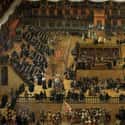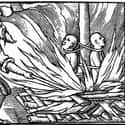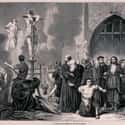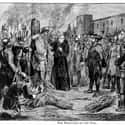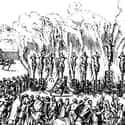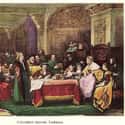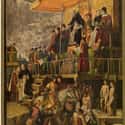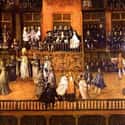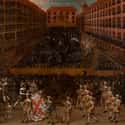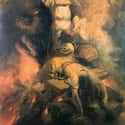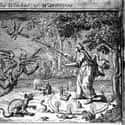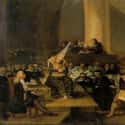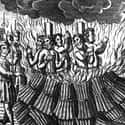-
(#1) It Was People's Favorite Form Of Theater
The auto de fé was the final stage of Inquisition proceedings. Though secrecy was paramount to the Inquisition trial stages leading up to the auto de fé, that was all abandoned on the day of the main event. Indeed, it was a form of public spectacle in which crowds of people turned up in city squares to watch the sentencing and punishment get carried out. As the ritual continued into the 17th century, the theater and spectacle of the auto de fé became even more elaborate, and common folks would eagerly read (or listen to) accounts of autos de fé they might've missed.
-
(#2) Some Of It Involved People Being Burned Alive
Perhaps the most extreme sentencing a person could receive during his or her very public auto de fé was burning. Being burned alive was a horribly painful, gruesome way to die - but it also attracted spectators who were hungry for a show. In Logroño, Spain, in 1610, six condemned witches were burned alive, making it the largest witch burning of the Spanish Inquisition. Historians remain divided over exact numbers, but they generally agree that around 3,000 people were burned alive as a result of an auto de fé. Some people were lucky: they were condemned to be burnt in effigy rather than in body.
-
(#3) Torture (Including Having Your Limbs And Head Cut Off) Was Common
Torture was definitely a part of the Inquisition process. Though it was controversial, it was within the rights of Inquisitors to use torture as a way to extract a confession during a trial. But the accused's suffering did not end when the trial did. The auto de fé - the final stage of an Inquisition trial - presented yet another opportunity for torture. If an accused person wasn't burned alive or sentenced to life in prison, a range of other punishments was possible. Some people were whipped and tortured in other brutal ways.
One of the most disturbing sentences happened in 1766, when the 19-year-old François-Jean de la Barre was sentenced to have his tongue and arm cut off before being burnt alive. Though his sentence was ultimately commuted to beheading and burning, it was still an outrage to people like Voltaire, who used the event to criticize the Catholic Church.
-
(#4) It Happened All Around The World
The origin of the phrase "auto-da-fé" speaks to where the ritual was developed: it's Portuguese and means "act of faith," as does the Spanish version, "auto de fé." In the early modern world, Portugal and Spain were expanding their global reach and colonizing the so-called "New World." So the Inquisition and autos de fé spread to the Americas where they fit in nicely with Spain's missionary projects in North and South America. Autos de fé sprung up everywhere from Mexico City to Lima. But autos de fé weren't just in the Americas - Goa even had its own Inquisition from 1560 to 1812.
-
(#5) The Last Auto De Fé Was In 1850 In Mexico
Autos de fé may have been a product of the early modern world, but they outlasted it. The autos de fé developed in the late 15th and 16th centuries, and the Enlightenment of the 18th century slowed them down a little bit in some parts of the world. But they actually continued well into the 19th century. Though the Inquisition in Mexico was abolished in 1820, there is a record of an auto de fé there as late as 1850.
-
(#6) Hundreds Of Thousands Of People Probably Went Through It
It is difficult to estimate the exact number of people who had to suffer through an auto de fé. Enactment of autos de fé varied by location and time. Some autos de fé were larger and more frenzied than others. But historians generally agree that in the heyday of the auto de fé, hundreds of thousands of people had to go through the dangerous, harmful, and humiliating ritual - and only the lucky ones survived.
-
(#7) It Was Both Religious And Political
Officially, the auto de fé was part of the Catholic Inquisition. Inquisitions were not civil affairs - they were handled by religious tribunals. At the same time, monarchical and governmental authorities played a part in the process. The Inquisition in Spain ramped up, for example, only when King Ferdinand and Queen Isabella were able to appoint their own Inquisitors and used them to challenge their political enemies.
Civil authorities also collaborated in the Inquisition process, and they would have been present at an auto de fé. Indeed, only civil authorities could condemn an accused person to be burned at the stake - the worst that religious officials could do was sentence someone to life in prison.
-
(#8) The Actual Public Ritual Could Last Hours
Though autos de fé often varied in size and scale, the most elaborate auto de fé spectacles were huge, public affairs. In Latin America, for example, these large-scale events took place over the course of several hours. Events would start the night before the spectacle, when a procession that included church officials and a choir marched through the streets. A second procession including civic officials and aristocrats happened the following morning. After the procession, spectators would utter an oath of loyalty, hear a sermon, and then watch the sentencing.
-
(#9) Prisoners Were Kept In The Dark About Their Fate Until The Auto De Fé
Secrecy was central to the Inquisition proceedings. This meant that prisoners would endure their trials only to have to wait longer to hear their fate. Often, they had to wait several days through the pomp and circumstance of the auto de fé to finally hear their sentence. Officials did this to limit the number of appeals higher courts might receive in the wake of trials. But waiting to hear their fate proved too excruciating for some, and there are records of prisoners committing suicide before hearing their sentencing.
-
(#10) The Autos De Fé Were About Power
Autos de fé were about the spectators and the power of the Catholic Church as much as they were about the individual victims. The public spectacle of autos de fé meant that everyone could see what they considered to be holy justice unfolding before them. Sinners were obviously punished, and so they served as a cautionary tale to all the spectators. The pomp and circumstance of the spectacle also accentuated the power of the Church as an institution that could discipline and punish by whatever means it deemed fit.
-
(#11) Despite Being A Test Of Catholic Faith, Many Victims Were Non-Catholics
The "act of faith" was specifically a mechanism to keep Catholics in line. But many of the victims of the auto de fé weren't actually even Catholic - autos de fé punished anyone who was labeled a "heretic." This included former Jews, Muslims, Protestants, as well as people who regarded religion with skepticism. In short, anyone who did not follow the Catholic Church's mandates and expectations was at risk of being brought before a tribunal and suffering through an auto de fé.
-
(#12) The Spectrum Of Potential Crimes Included Witchcraft And Bigamy
Though what counted as "heresy" created a pretty broad umbrella, there was a relatively large spectrum of crimes that might result in an auto de fé. These were largely considered to be crimes against religion. For one, anyone who did not follow the practices of Roman Catholicism might be targeted. But allegations made against someone of things like witchcraft or bigamy could also land that person in front of a tribunal.
-
(#13) Not Everyone Loved A Good Burning
By the 18th century, Europe was deep in the age known as the Enlightenment, a time when the values of tolerance and humanitarianism began to take root. But, progress wasn't universal; autos de fé persisted in many parts of Europe and its colonies into the 19th century. Voltaire, one of the leading figures of the French Enlightenment, was a fierce critic of autos de fé. He even satirized them in his anti-religious work Candide.
-
(#14) The Accused Had To Wear Special Clothing To Mark And Humiliate Them
As part of the spectacle of the auto de fé, prisoners had to appear in special clothing. Known as the "sanbenito," the garments were a coded yellow tunic that would reveal a prisoner's crimes and fate. They were decorated with symbols and colors. People who were condemned to die wore the Samarra tunic, which had pictures of flames sewn on it. The condemned had to walk through the streets in this garment with a rope around their neck and while carrying a candle. Often, they also wore large pointed hats.
-
(#15) One Of The Largest Autos De Fé Happened In Mexico
In some ways, the colonies outdid Europe in terms of autos de fé. The largest auto de fé in the Americas happened in Mexico in 1649. Over 100 so-called "Judaizers" were condemned for supposedly trying to convert people to Judaism. Of those, 13 were burned at the stake.
New Random Displays Display All By Ranking
About This Tool
Auto De Fe Atomic Portuguese is a public religious trial and confession ceremony in the Middle Ages. The Spanish Inquisition or the Portuguese Inquisition imposed penalties on pagans and heretics. In fact, most of the prisoners were executed by the secular authorities after the confession. The most common victims were former Jews and former Muslims who were apostates.
To understand the nature of the Inquisition, we must understand that the Middle Ages is indeed a backward era. The random tool explained 15 brutal facts about Auto De Fe that you never know, in the centuries that the Inquisition has existed, many improper trials have been conducted in the name of religion.
Our data comes from Ranker, If you want to participate in the ranking of items displayed on this page, please click here.










